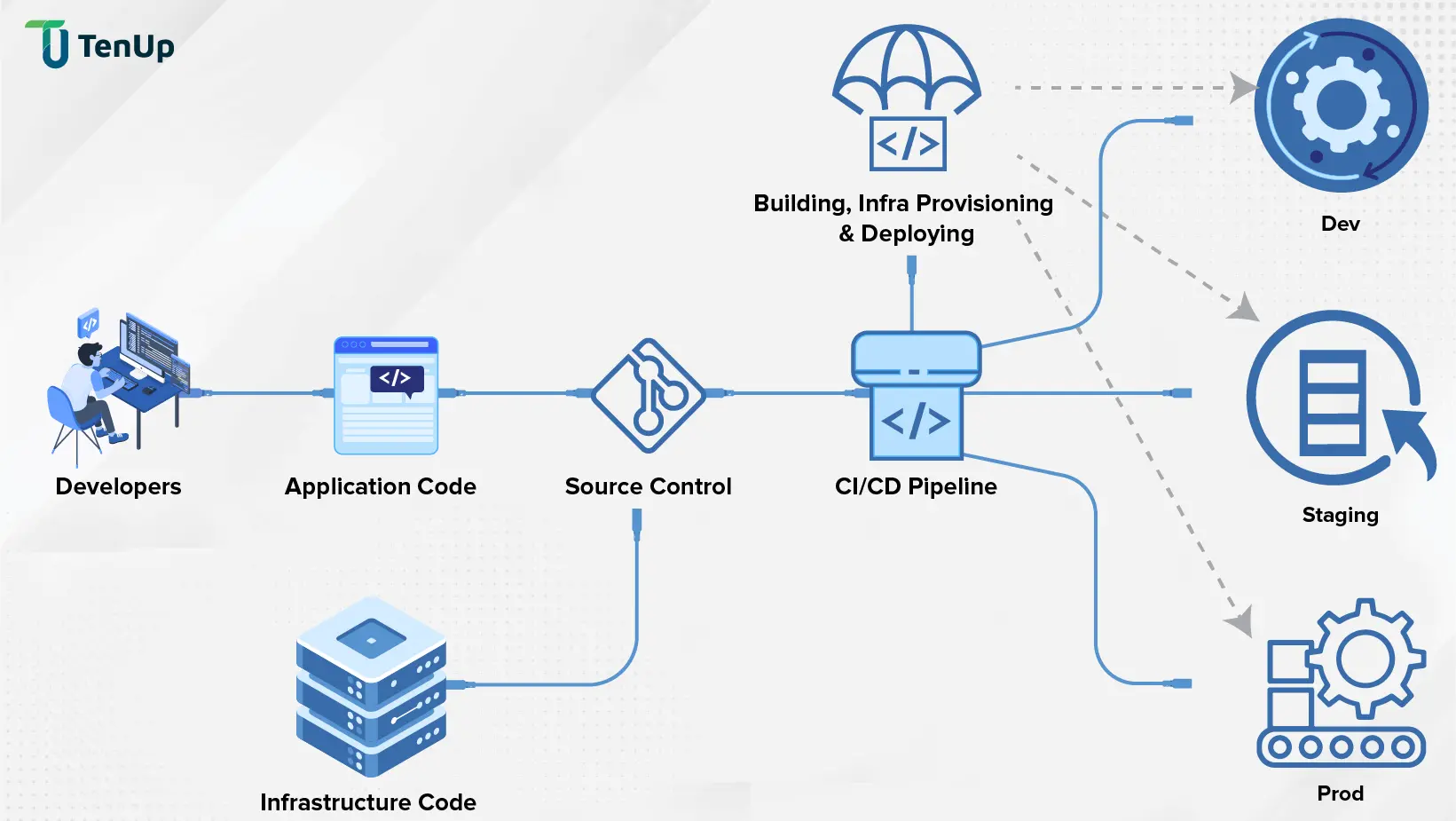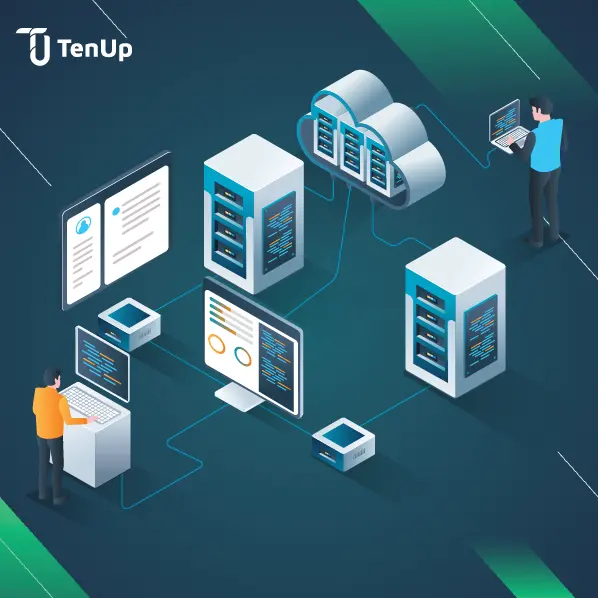Modern computing often faces the challenges of environment drift in the release pipeline. When teams build against staging or development environments and find that the production environment is out of sync, it leads to significant waste of time, resources, and efficiency in investigating the issues.
Infrastructure as Code (IaC) addresses these challenges by providing:
- Automated infrastructure provisioning: Reduces manual setup and errors.
- Faster development and deployment: Enables teams to scale cloud applications quickly.
- Cost and risk reduction: Minimizes resource wastage and deployment failures.
- Consistent environments: Maintains alignment across development, testing, and production stages.
Many organizations now integrate IaC-driven DevOps automation into their workflows, optimizing the entire software lifecycle for scalability, reliability, and efficiency.
Infrastructure as Code (IaC): What It Is & Why It Matters
Infrastructure as Code (IaC) is a core DevOps automation practice that uses machine-readable configuration files to automate and manage IT infrastructure. Rather than manually setting up servers, networks, and resources, IaC automation allows developers to define and provision infrastructure programmatically. This approach ensures consistency, scalability, and faster deployments while minimizing human error. Popular IaC tools like Terraform IaC, AWS CloudFormation, and Ansible help teams manage multi-cloud environments efficiently.
Key principles and benefits of IaC include:
- Versioned infrastructure management: Infrastructure is treated like source code, enabling consistent replication of environments.
- Repeatable deployments: Just as the same source code generates the same binary, an IaC model produces the same environment every time it is applied.
- Continuous delivery support: Facilitates automated provisioning and integration into CI/CD pipelines.
- Multi-cloud efficiency: Helps manage complex cloud infrastructures with standardized configurations.
IaC has now become a vital DevOps practice, providing a reliable foundation for automating infrastructure, reducing errors, and supporting continuous delivery across development, testing, and production environments.
How IaC Prevents Environment Drift in Deployments

As mentioned earlier, IaC evolved as a means to tackle the challenge of environment drift in the release pipeline. In the absence of IaC, teams had to maintain the settings of individual deployment environments. Unfortunately, over time, each environment would become what is called a ‘snowflake’, a unique configuration that is impossible to reproduce automatically. This led to inconsistency within environments and issues during deployments. To manage snowflakes, administration and maintenance required manual processes that are hard to track and error-prone.
Key principles of IaC in managing environment drift include:
- Idempotence: IaC functions on the principle of idempotence, meaning the deployment command sets the target environment to the same configuration, no matter the environment’s initial state.
- Automatic Configuration: Idempotency is achieved either by automatically configuring an existing target or by removing the existing target and creating a fresh environment.
- Versioned Configuration Models: IaC teams make changes to environment descriptions and version the configuration models in documented code formats such as JSON.
- Source-driven Updates: As the release pipeline executes the model to configure target environments, teams can make changes to the source and not the target, ensuring consistency and reproducibility.
By combining these principles, IaC ensures consistent, reliable, and scalable infrastructure management across all stages of the deployment pipeline.
Top Benefits of Infrastructure as Code for Businesses
Implementing Infrastructure as Code (IaC) offers several transformative business benefits, from automated infrastructure management to improved configuration consistency. It’s a core enabler of digital transformation, helping organizations streamline operations and achieve scalability at speed.
Here’s how IaC drives tangible business outcomes:
- Automation and Consistency: IaC enables full automation of IT infrastructure management, reducing human intervention and ensuring configuration uniformity across environments.
- Reduced Overhead: By removing manual setup and repetitive tasks, organizations can lower IT operational costs and allocate resources to more strategic initiatives.
- Improved Scalability and Efficiency: Automated provisioning helps maintain consistent performance even during demand spikes, ensuring better availability and resilience.
The biggest benefit, however, is speed.
Manual configuration can be slow, and applications often struggle during traffic surges. With IaC, system administrators no longer need to manually provision or configure servers—infrastructure scales automatically through predefined scripts, improving time-to-deploy and reducing bottlenecks.
Another major advantage is monitoring and visibility.
With special-purpose IaC monitoring tools, teams gain:
- Full visibility into infrastructure performance
- Real-time topology mapping to identify dependencies and detect anomalies early
- Proactive issue detection, ensuring there are no blind spots across systems
Finally, IaC helps eliminate configuration drift.
When multiple people manually deploy configurations, discrepancies are inevitable. IaC centralizes all infrastructure definitions in version-controlled code, creating a single source of truth for deployment consistency across development, testing, and production environments.
How Our IaC Solutions Help Businesses Scale Faster
Scaling cloud infrastructure efficiently is crucial for modern businesses, and Infrastructure as Code (IaC) is at the core of automation and rapid growth. Companies adopting IaC report up to 70% faster deployment times, reduced operational overhead, and more consistent environments across development, staging, and production.
By integrating IaC in DevOps pipelines, your teams can focus on delivering features while our solutions ensure your infrastructure remains scalable, secure, and cost-efficient. Here’s what our IaC solutions deliver:
- Automated Infrastructure Provisioning: Reduce manual configuration and speed up environment setup.
- Consistent and Repeatable Deployments: Ensure uniformity across all environments to prevent drift.
- Enhanced Collaboration: Seamless alignment between development and operations teams.
- Cost Optimization: Minimize cloud resource wastage and optimize spending.
With the global IaC market projected to grow from $850 million in 2024 to $7.1 billion by 2034, businesses that adopt IaC now are positioned to gain a significant competitive advantage.
Declarative vs. Imperative IaC: Key Differences
Infrastructure as Code (IaC) can be configured using two main approaches — declarative and imperative.
The declarative approach focuses on defining the desired end state of the infrastructure. You specify what resources are required and the properties they should have, and the IaC tool automatically provisions the infrastructure to match that state.
In contrast, the imperative approach takes a more step-by-step method. It maintains a record of the current state of your system objects, making it easier to modify or take down the infrastructure when needed.
Here’s how both approaches differ in practice:
- Declarative IaC: You describe the final desired configuration, and the tool determines how to achieve it. Any updates made to the desired state are automatically applied by the tool.
- Imperative IaC: You define the exact sequence of actions to reach the desired state. When changes are needed, you must specify how those changes should be implemented.
Many modern IaC tools support both approaches, allowing teams to choose the method that best fits their workflow and infrastructure management strategy.
How IaC Powers DevOps & Cloud Automation
Repeatability, auditability, and simplicity are crucial for successful DevOps initiatives, and Infrastructure as Code (IaC) plays a central role in achieving them. Integrating IaC in DevOps pipelines ensures consistency and automation during CI/CD implementation. It removes the burden of manual provisioning from developers, enabling them to execute scripts that instantly deploy and configure infrastructure across multi-cloud environments—accelerating release cycles and enhancing DevOps scalability.
Key benefits of IaC in DevOps pipelines include:
- Eliminates deployment delays: There are no delays in application deployment caused by infrastructure provisioning, and system administrators are no longer held up by time-consuming manual processes.
- Supports CI/CD automation: Continuous Integration and Continuous Deployment (CI/CD) relies on ongoing automation and continuous monitoring across the application development lifecycle, from integration and testing to delivery and deployment.
- Ensures consistency: For an environment to be automated effectively, consistency is essential. IaC ensures that development and operations teams deploy and configure applications without discrepancies.
- Aligns development and operations: Both teams use the same description of application deployment, making IaC a truly DevOps-driven approach.
By leveraging IaC, organizations can streamline deployment processes, reduce human error, and enhance overall operational efficiency while maintaining a consistent and repeatable DevOps workflow.
Best Infrastructure as Code Tools for DevOps
There are several Infrastructure as Code (IaC) tools available today, each designed to automate recurring tasks like configuration, provisioning, and deployment. These tools play a critical role in enabling DevOps teams to deliver consistent, scalable, and secure infrastructure environments.
Some of the most widely adopted IaC tools include:
1. ServerLess Framework
The ServerLess framework offers zero-friction development and helps define applications as functions and events. Developers can declare AWS Lambda functions and their triggers using a simple YAML-based syntax.
- Enables deployment of infrastructure and code with a single command, ensuring AWS Lambda functions, triggers, and code are automatically deployed and integrated in the cloud.
- Supports extensive plugin integrations, allowing developers to extend use cases and workflows.
- Offers thousands of plugins that can integrate with third-party tools, enhancing flexibility and automation.
2. AWS Cloud Development Kit (AWS CDK)
The AWS CDK is a software development framework used to define cloud infrastructure in code and provision it through AWS CloudFormation. It enables developers to design cloud applications using familiar programming languages, making infrastructure management more intuitive.
- Supports languages such as TypeScript, JavaScript, Python, Java, C#/.NET, and Go (developer preview).
- Allows creation of reusable cloud components, known as Constructs, for scalable and cost-effective architectures.
- Simplifies cloud setup by abstracting complex AWS configurations into reusable code modules.
3. Terraform by HashiCorp
Terraform, developed by HashiCorp, is an open-source infrastructure automation tool and one of the most popular choices in the DevOps ecosystem. It allows users to configure, provision, and manage infrastructure as code across multiple providers with a single, unified workflow.
- Uses a declarative approach to define desired infrastructure states.
- Offers multi-cloud compatibility, enabling deployments across AWS, Azure, Google Cloud, and more.
- Provides a consistent CLI workflow, reducing complexity in managing heterogeneous environments.
According to the 2023 State of IaC Report, Terraform continues to dominate the IaC landscape, with over 90% of cloud users leveraging some form of Infrastructure as Code in their workflow.
4. Other Popular IaC Tools
Beyond these major platforms, several other tools are frequently used by DevOps teams to manage infrastructure at scale:
- Azure Resource Manager (ARM) – Automates deployment and management of Azure resources.
- Ansible – Uses YAML playbooks for configuration management and provisioning.
- Google Cloud Deployment Manager – Defines cloud resources declaratively for GCP.
- Chef & Puppet – Widely used for configuration management and policy enforcement.
Top IaC Tools & Enterprise Plans for Your Business
Choosing the right IaC tools is essential for achieving automation, scalability, and operational efficiency. We work with top tools like Terraform, AWS Cloud Development Kit (CDK), Serverless Framework, and Ansible, helping organizations automate infrastructure provisioning, manage multi-cloud environments, and maintain consistency across all deployments.
Our expertise also extends to enterprise plans for these tools, which provide advanced features like governance, monitoring, and team collaboration:
- Terraform Enterprise: Policy as code, collaboration, and governance for large teams.
- AWS CDK Pro: Cross-account deployments and enhanced security controls.
- Serverless Framework Dashboard: Monitoring, alerts, and enterprise team collaboration.
- Ansible Tower: Centralized automation with role-based access and job scheduling.
With the IaC market growing rapidly and cloud adoption increasing, integrating these tools into your DevOps workflow ensures scalable, secure, and cost-effective operations. Our team guides you in selecting the right tools and enterprise plans, integrating them seamlessly into your infrastructure while maximizing ROI.
Conclusion: How Infrastructure as Code Drives Scalability and Efficiency in DevOps
Infrastructure as Code (IaC) remains one of the most impactful DevOps automation practices used alongside continuous delivery. It provides changeless infrastructure, faster go-to-market, improved scalability, cost efficiency, and better risk management. As production and delivery cycles grow, IaC tools such as Terraform, AWS CloudFormation, and Ansible continue to revolutionize how teams design, test, and deploy cloud-based applications—helping businesses scale operations efficiently through infrastructure automation.
To fully leverage the benefits of IaC and other DevOps practices, organizations are increasingly relying on expert DevOps services to ensure streamlined operations, faster delivery, and robust infrastructure. Learn more about how our DevOps services can help your business scale efficiently and achieve seamless integration.
Frequently asked questions
How does Infrastructure as Code accelerate DevOps scalability in real-world projects?
Infrastructure as Code (IaC) boosts DevOps scalability by automating infrastructure setup and management through code. It enables rapid, consistent environment creation, reduces manual errors, and supports dynamic scaling as workloads grow. By integrating with CI/CD pipelines, IaC speeds up deployments, improves reliability, and ensures seamless scalability across cloud environments.
What’s the difference between using Terraform and AWS CloudFormation for large-scale automation?
Terraform is a multi-cloud IaC tool that supports AWS, Azure, and GCP, offering flexibility and reusable modules for complex, large-scale automation. In contrast, AWS CloudFormation is AWS-native, providing deeper integration, managed state handling, and built-in security controls. Terraform is ideal for hybrid or multi-cloud scalability, while CloudFormation suits enterprises fully invested in the AWS ecosystem.
How does Infrastructure as Code support continuous delivery and CI/CD automation?
Infrastructure as Code (IaC) automates environment provisioning within CI/CD pipelines, ensuring consistent, version-controlled infrastructure across all stages. By treating infrastructure like application code, IaC enables faster, repeatable deployments, eliminates configuration drift, and ensures every release is tested and deployed in a stable, production-like environment—streamlining continuous delivery.
Can Infrastructure as Code work across hybrid or multi-cloud environments?
Yes. Infrastructure as Code (IaC) enables unified management across hybrid and multi-cloud setups by using provider-agnostic tools like Terraform and Ansible. It allows teams to define, deploy, and scale resources consistently across AWS, Azure, GCP, and on-premises systems—all from a single codebase—ensuring consistency, governance, and faster scalability.
Which service offers the best support for Infrastructure as Code deployments?
Terraform, AWS CloudFormation, and Pulumi are among the best platforms for Infrastructure as Code (IaC) deployments. Terraform excels in multi-cloud automation, CloudFormation offers deep AWS integration, and Pulumi enables coding in familiar languages—each delivering reliable, scalable, and consistent infrastructure management for modern DevOps teams.
Who provides managed Infrastructure as Code solutions for enterprise environments?
Leading providers like HashiCorp (Terraform Cloud), AWS (CloudFormation & CDK), Microsoft Azure (ARM & Bicep), and Google Cloud Deployment Manager deliver managed IaC solutions for enterprises. These platforms offer built-in governance, access control, compliance policies, and automated pipelines—enabling secure, large-scale infrastructure management across cloud environments.
What companies specialize in Infrastructure as Code automation for cloud infrastructure?
Leading companies like HashiCorp (Terraform), Red Hat (Ansible), Pulumi, and Puppet specialize in Infrastructure as Code automation. Their tools streamline cloud provisioning, enforce configuration consistency, and accelerate DevOps adoption—enabling scalable, reliable infrastructure management across AWS, Azure, and Google Cloud.
Where can I get Infrastructure as Code platforms that support collaboration across teams?
Platforms like Terraform Cloud, Spacelift, and Pulumi Cloud offer strong team collaboration for Infrastructure as Code. They include shared state management, role-based access control, policy enforcement, and Git-based workflows—allowing DevOps, development, and security teams to manage infrastructure collaboratively with governance and visibility.

